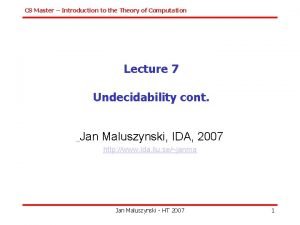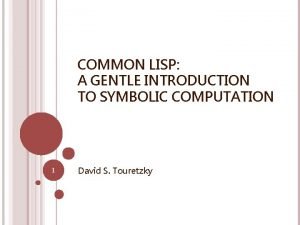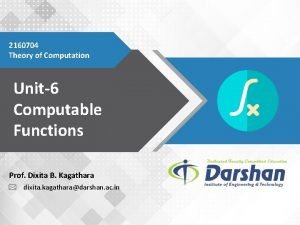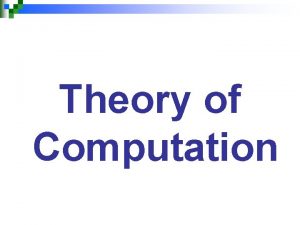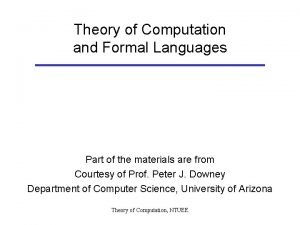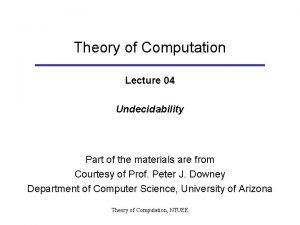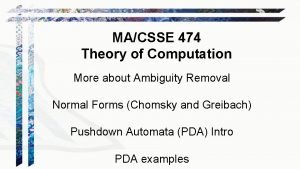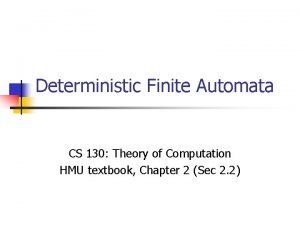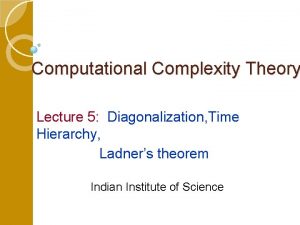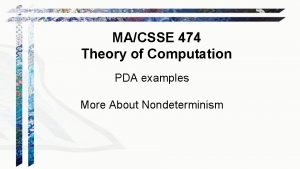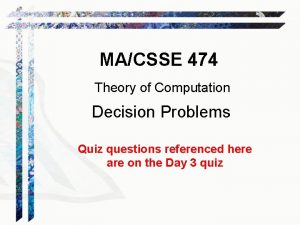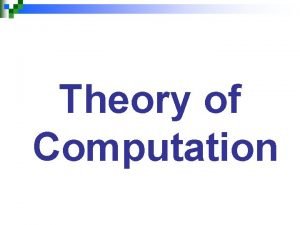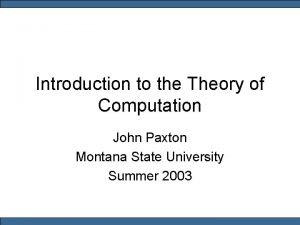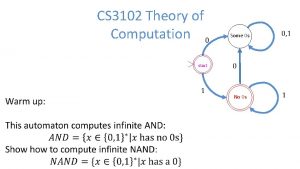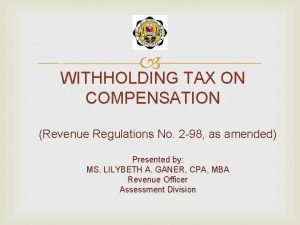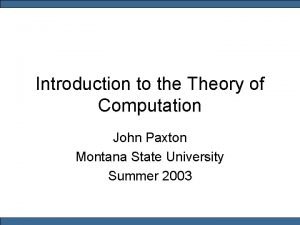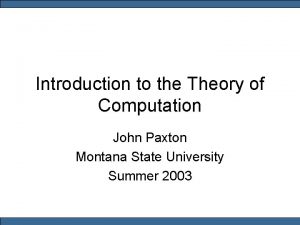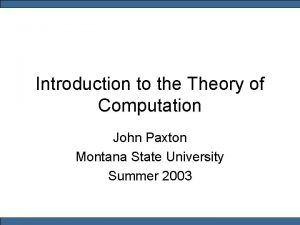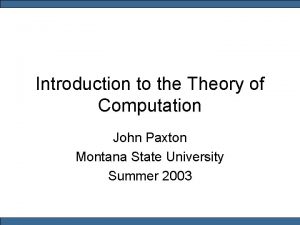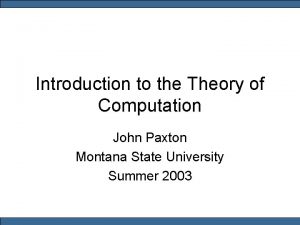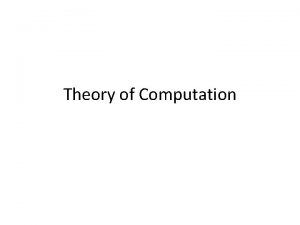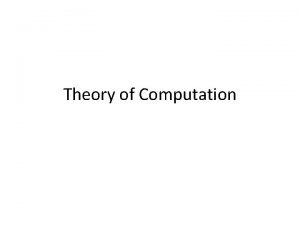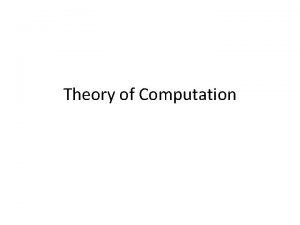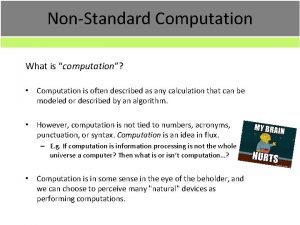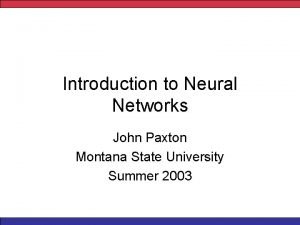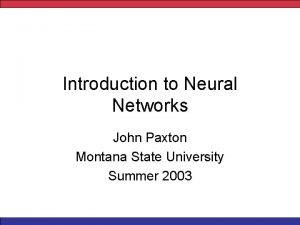Introduction to the Theory of Computation John Paxton



















- Slides: 19

Introduction to the Theory of Computation John Paxton Montana State University Summer 2003

Textbook Introduction to the Theory of Computation Michael Sipser PWS Publishing Company 1997

Humor • One night, Bill Clinton was awakened by George Washington's ghost in the White House. Clinton saw him and asked, "George, what is the best thing I could do to help the country? " "Set an honest and honorable example, just as I did, " advised George. The next night, the ghost of Thomas Jefferson moved through the dark bedroom. "Tom, what is the best thing I could do to help the country? " Clinton asked. "Cut taxes and reduce the size of government, " advised Tom. Clinton didn't sleep well the next night, and saw another figure moving in the shadows. It was Abraham Lincoln's ghost. "Abe, what is the best thing I could do to help the country? " Clinton asked. "Go to theatre. "

Chapter 1: Regular Languages • Very simple model of computation

1. 1 Finite Automaton • A finite state automaton (FSA) is a very simple model of computation. • Studying an FSA allows us to better understand more complex models of computation. • An FSA can be used in a compiler to tokenize the input.

Example 1 0 1 1 q 0 q 1 0

Example 1 Questions • What is the start state? • What is the set of accept states? • What sequence of states are gone through on input 0111001? • Is the empty string input (e) accepted?

Formal Definition A finite automaton is a 5 -tuple (Q, S, d, q 0, F) where 1. Q is a finite set called the states 2. S is a finite set called the alphabet 3. d : Q x S Q is the transition function 4. q 0 Î Q is the start state 5. F Í Q is the set of accept states

Example 1 Formal Definition • • Q = { q 0, q 1 } S = {0, 1} F = { q 1 } d 0 1 q 0 q 1

Language of Machine M • L(M) = A where A is the set of all strings that machine M accepts. • L(Example 1) = { w | w ends in a 1 } • M “recognizes” A

Acceptance Let M = (Q, S, d, q 0, F) be a finite automaton and w = w 1 w 2 …wn be a string over the alphabet S. Then M “accepts” w if a sequence of states r 0 r 1…rn exists in Q with the following three conditions: 1. r 0 = q 0 2. d(ri, wi+1) = ri+1 for 0 <= i <= n – 1 3. rn Î F

Regular Language A language is called a “regular language” if some finite automaton recognizes it.

Exercises • Design a finite automaton that recognizes the regular language of all strings that contain the string 001 as a substring. The alphabet is {0, 1, 2}. • Design a finite automaton that recognizes all binary numbers that are multiples of 3. • Design a finite automaton that recognizes all binary strings with a 1 in the kth position where k > 0.

Regular Operations • Union A U B = { x | x Î A or x Î B} • Concatenation A B = { xy | x Î A and y Î B} • Star A* = {x 1 x 2…xk | k >= 0 and xi Î A}

Theorem The class of regular languages is closed under the union operation. In other words, if A 1 and A 2 are regular languages, so is A 1 U A 2.

Proof • M 1 = (Q 1, S, d 1, q 1, F 1) • M 2 = (Q 2, S, d 2, q 2, F 2) • Construct M = (Q, S, d, q 0, F)

Proof (by construction) • • Q = {(r 1, r 2) | r 1 Î Q 1 and r 2 Î Q 2 q 0 = (q 1, q 2) F = {(r 1, r 2) | r 1 Î F 1 or r 2 Î F 2} d((r 1, r 2), a) = (d 1 (r 1, a), d 2 (r 2, a) )

Exercise • Use the preceding construction to construct a FSA that accepts the union of L(A 1) = { w | w ends in 1 } and L(A 2) = { w | w contains the substring 00 }

More Theorems • The class of regular languages is closed under the concatenation operation. • The class of regular languages is closed under the star operation. • Proofs: easier with the concept of nondeterminism!
 Fish morphology worksheet answers
Fish morphology worksheet answers Autumn vinciquerra
Autumn vinciquerra Donna paxton
Donna paxton Sipser, m: introduction to the theory of computation
Sipser, m: introduction to the theory of computation Cosc 3340
Cosc 3340 Common lisp a gentle introduction to symbolic computation
Common lisp a gentle introduction to symbolic computation Theory of computation
Theory of computation Graph transition
Graph transition Types of languages in theory of computation
Types of languages in theory of computation Theory of computation
Theory of computation Ambiguity
Ambiguity Theory of computation
Theory of computation Diagonalization method in theory of computation
Diagonalization method in theory of computation Anbn pda
Anbn pda Theory of computation quiz
Theory of computation quiz Computation
Computation Nfa theory of computation
Nfa theory of computation The theory of computation
The theory of computation Cs 3102
Cs 3102 Who is not subject to withholding tax on compensation
Who is not subject to withholding tax on compensation




